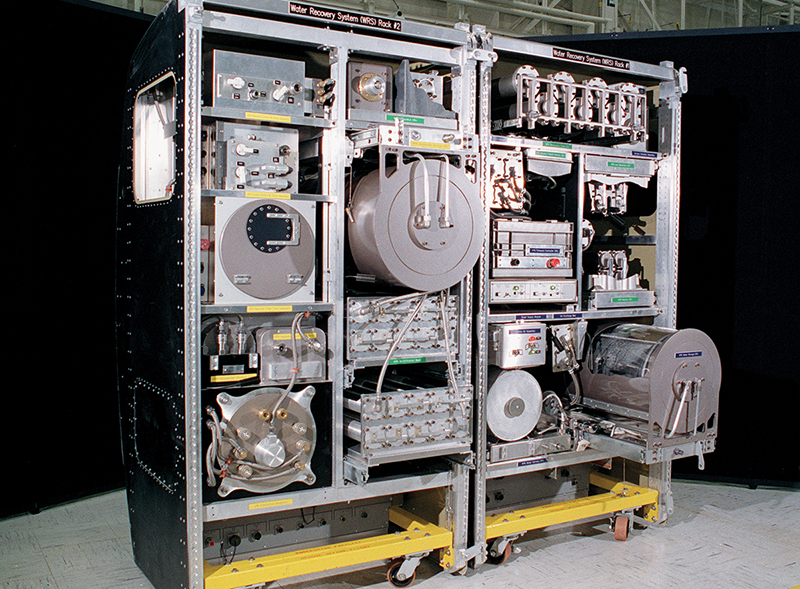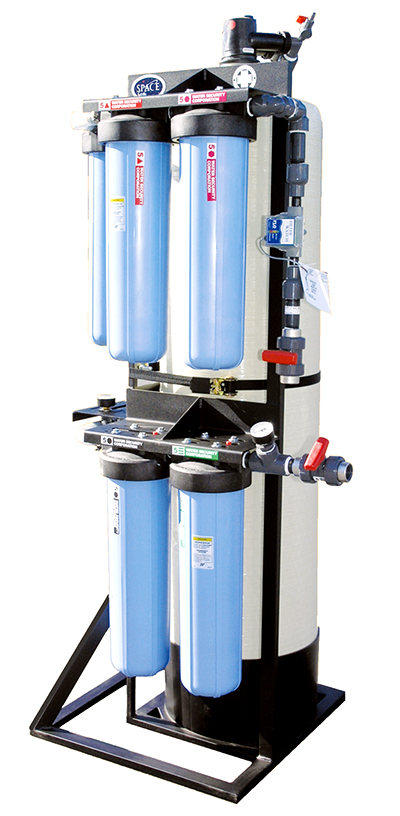
Clean Water for Remote Locations
Originating Technology/NASA Contribution
Water is indispensable for human health and well-being. A person cannot live for more than a few days without clean, drinkable water. It is, therefore, one of the most crucial provisions astronauts need to live and work in space, whether orbiting Earth, working at a lunar base, or traveling to Mars.
Currently, astronauts aboard the International Space Station (ISS) receive their water from Russian delivery missions and from a device that catches some moisture from respiration and recycles it into limited amounts of drinking water. This water replenishment is a costly endeavor, and engineers are working on ways to make the process more efficient.
Toward that effort, Marshall Space Flight Center engineers are working on creating the Regenerative Environmental Control and Life Support System, a complex system of devices intended to sustain the astronauts living on the ISS and, in the future, sustain those who are blasting off to the Moon or Mars.
The devices make use of the available resources, by turning wastewater from respiration, sweat, and urine into drinkable water.
One of the devices that Marshall has been working on is the Water Recovery System (WRS). Marshall has teamed with long-time NASA contractor, Hamilton Sundstrand Space Systems International, Inc., of Windsor Locks, Connecticut. Hamilton Sundstrand, the original designer of the life support devices for the space suits, developed the Water Processor Assembly (WPA). It, along with the Urine Processor Assembly (UPA) developed by Marshall, combines to make up the total system, which is about the size of two refrigerators, and will support up to a six-member crew. The system is currently undergoing final testing and verification.
“The Water Processor Assembly can produce up to about 28 gallons of potable recycled water each day,” said Bob Bagdigian, Marshall Regenerative Environmental Control and Life Support System project manager. After the new systems are installed, annual delivered water to the ISS should decrease by approximately 15,960 pounds, or about 1,600 gallons.
The WPA is tentatively scheduled for launch in 2008, but the technology is finding applications on Earth well before that date.
Partnership
Water Security Corporation, Inc., of Sparks, Nevada, owns the patents for the commercial use of this technology and has begun to offer it around the world—anywhere people need affordable, clean water.
The company’s terrestrial water treatment device has been recognized by the Space Foundation as a Certified Space Technology, not only for its use of space know-how, but also for its humanitarian mission. “Water Security Corporation’s technology was awarded the Certified Space Technology seal, because it effectively applies space-based knowledge to a needed application on Earth,” said Kevin C. Cook, director of brand management for the Space Foundation. “Their water filtration systems are providing safe, affordable drinking water throughout the world.”
Product Outcome
By combining the benefits of chemical adsorption, ion exchange, and ultra-filtration processes, Water Security Corporation’s products yield safe, healthy, good-tasting water from the most challenging water sources, such as in underdeveloped regions where well water may be heavily contaminated with bacteria.
The patented Microbial Check Valve (MCV), created by UMPQUA Research Company, of Myrtle Creek, Oregon, releases iodine into the water, which then kills bacteria and viruses. The next step is to add a proprietary resin called Iodosorb that functions as an iodine scrubber. Testing of the system demonstrates 6-log bacteria kill (99.9999 percent) and 4-log virus kill (99.99 percent), which meets U.S. Environmental Protection Agency standards and is equivalent to, if not better than, water in many industrialized countries.
The United Nations estimates that 1 billion people lack access to safe drinking water, 10 million people die each year of waterborne diseases, and 2 million of those deaths are children. The major sources of this contaminated water are bacteria, viruses, and cysts. These pathogenic organisms breed in unprotected water and unsanitary conditions. Even cleanup efforts are often thwarted by recontamination of treated water during transportation and storage prior to use. The spaceborne technology is uniquely suited to address these concerns.
One of the innovative products using this patented space technology is Water Security Corporation’s Discovery – Model WSC4. Discovery has a 4-gallon- per-minute output and a 30,000-gallon capacity. It is ideal for rural water disinfection applications and was specifically designed to filter and disinfect fresh water that may be microbiologically contaminated. Its modular construction and simple maintenance procedures make it an ideal solution for remote installations and situations where the quality of supplied water is unsatisfactory. It can be carried by trailer to locations in need of fresh water and requires little training to operate.
Another model that Water Security Corporation has created is the Apollo – Model WSC 0.5. Smaller than the Discovery, it is mobile and ideal for remote locations, as well as mobile disaster relief. While still providing the same level of water filtration and purification as its larger kin, the Apollo has a reduced flow capacity of 2 liters per minute. This reduced flow is offset by the fact that the Apollo model can be lifted easily into the bed of a pickup truck and driven to wherever clean water is needed. This unit can be operated with a generator or even with a hand pump.
Water Security Corporation is currently in the process of making a countertop model using the same MCV technology. This would be useful in urban areas, where piped-in water is still subject to contamination. In some developed nations, it is not uncommon for municipalities to issue “boil water alerts” when the water systems become overloaded, or perhaps during an E. coli scare. The countertop unit would be ideal for these locations.
Microbial Check Valve® and MCV® are registered trademarks of Water Security Corporation, Inc.

The Discovery – Model WSC4 unit pictured here has been deployed to rural areas around the world to assist in providing people with clean, drinkable water.

This is a close-up view of the Water Recovery System (WRS) racks, the hardware that will allow a constant supply of clean water for four to six crewmembers aboard the ISS. The WRS provides clean water through the reclamation of wastewaters, including water obtained from the space shuttle’s fuel cells; crewmember urine; used shower, handwash, and oral hygiene water; cabin humidity condensate; and extravehicular activity waste.













